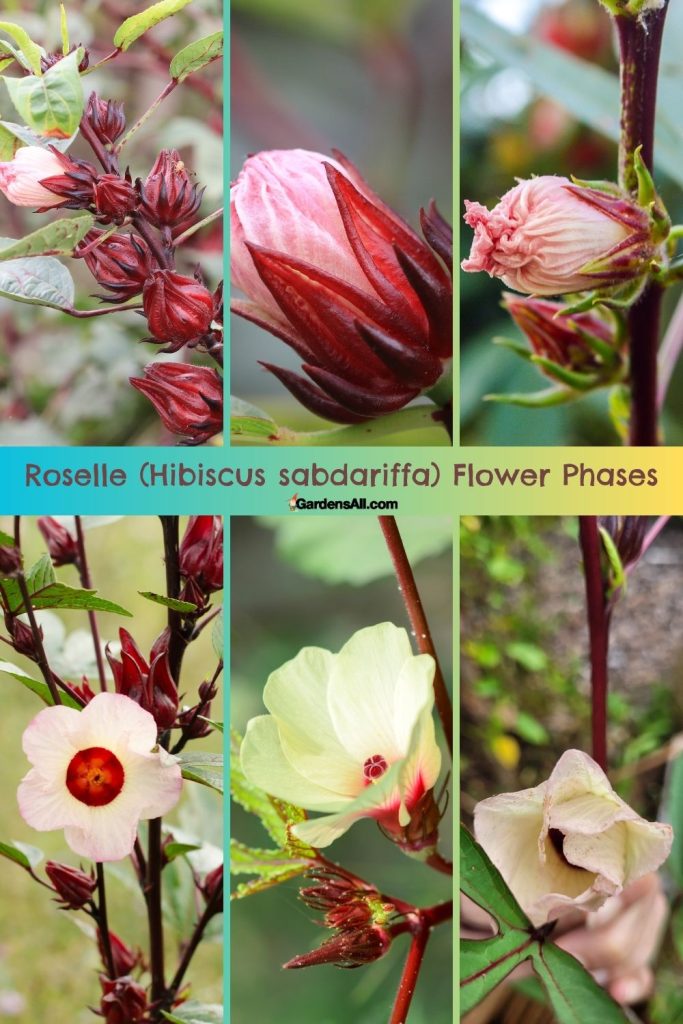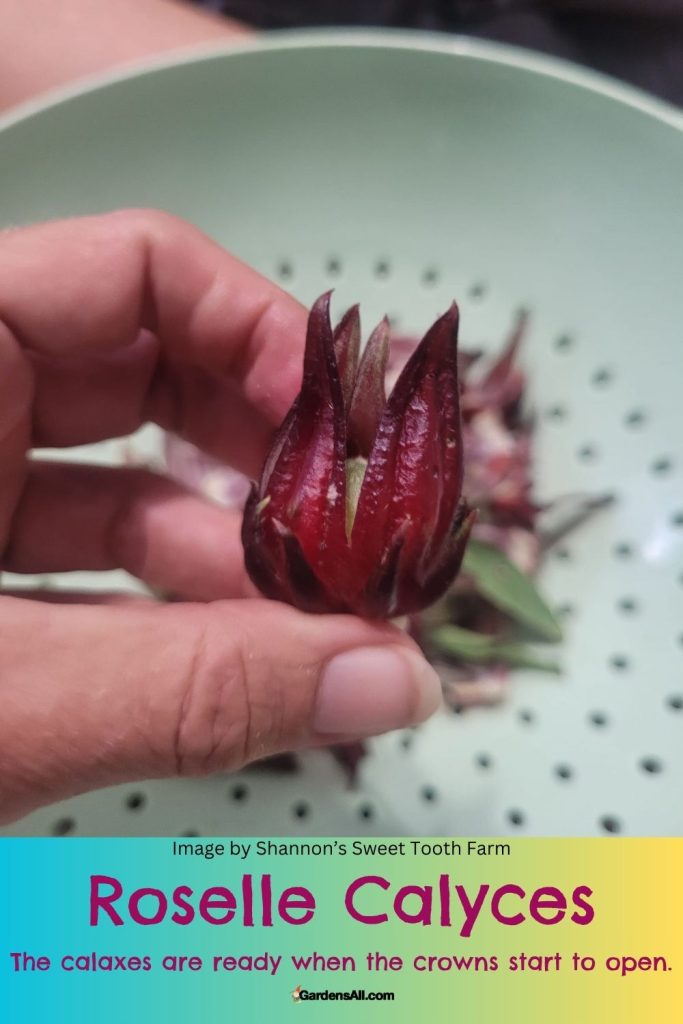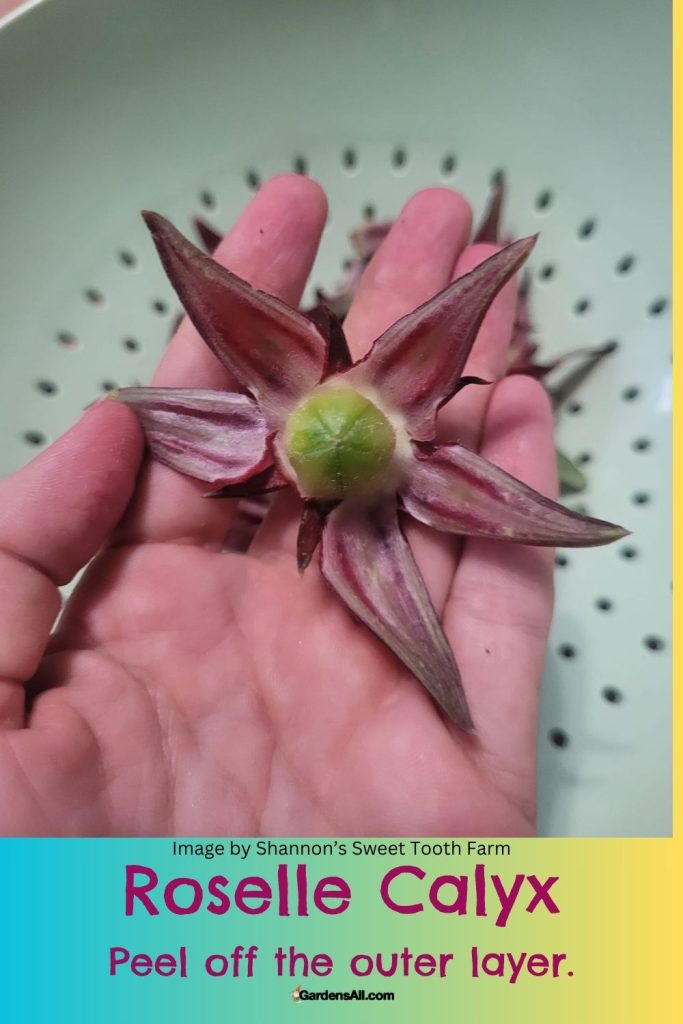Hibiscus sabdariffa, is the plant renowned for the delightfully fruity and nutritionally rich hibiscus tea. If you’re new to growing it and wondering how and when to harvest Roselle this will help. But first, a brief introduction to this magnificent plant!
What is Roselle?
Roselle (Hibiscus sabdariffa), is a member of the hibiscus family, native to Africa but now cultivated in many regions across the world. Noted for its bright red calyces (the protective, outer layer of the flower bud), Roselle is grown primarily for these calyces which are used to make herbal teas, jellies, jams, and a variety of beverages.
What is the Roselle Hardiness Zones?
While Roselle is a tropical to subtropical perennial in warmer climates. So for growing it outdoors year round, Roselle is best suited for USDA Hardiness Zones 9-11. Alternately, you can grow it an an annual in other zones.
- Zone 9: Minimum temperatures of 20°F to 30°F (-6.6°C to -1.1°C).
- Zone 10: Minimum temperatures of 30°F to 40°F (-1.1°C to 4.4°C).
- Zone 11: Minimum temperatures of 40°F to 50°F (4.4°C to 10°C).
If you’re in Zones 9 or below, you’ll likely need to grow Roselle as an annual, starting it early indoors or using it as a summer crop, as it is sensitive to frost. In Zones 10 and 11, Roselle can be grown more comfortably, as these zones are less likely to experience frost or freezing temperatures that can harm the plant.
For those who don’t reside in these zones but are keen to grow Roselle, it’s possible with some extra care. You can start seeds indoors and transplant them after the last frost, ensuring that you offer protection (like a cold frame or frost cloth) if there’s a risk of unexpected cold snaps.
Alternately, you can grow Roselle in containers. That’s what we do in zone 7, and we bring it indoors in winter. It doesn’t love it, but tolerates it and then returns to thriving easily once back outdoors after the last frost.
Whichever growing method you choose, a little TLC and consistent watering and fertilization during the growing phase can significantly influence the quality of the harvested calyces.
When to Harvest Roselle
Typically, Roselle plants mature in about 4-6 months after planting. The ideal time to harvest Roselle is when the calyces are fully developed but before they become dry and brittle.
- Flowers Fading: As the flower petals fade or wilt, it indicates that the fruit (or seedpod) inside the calyx is beginning to develop.
- Calyx Color: Mature calyces are usually bright red or dark pink. This rich color is one indication that they are ready for harvesting.
- Seedpod Development: The seedpod inside the calyx will start to swell as it matures. When the seedpod has filled out the calyx but is still tender, it’s the perfect time to harvest.
- Avoid Over-maturity: Over-mature calyces can be hard, dry, and less flavorful. If the calyces are left too long on the plant, they can become woody and lose their desirable tartness. However, if this has happened with your plants, you can still use the dried calyces, fruit and seeds for tea, powders and smoothies.
When the seedpod has filled out the calyx but is still tender, it’s the perfect time to harvest.
How to Harvest Roselle
- Tools: Ensure you have sharp and clean pruning shears or scissors. This ensures a clean cut and reduces damage to the plant.
- Method:
- Start by holding the calyx with one hand and snipping it off with the other at the stem under the base.
- While the calyces are the primary part harvested, young roselle leaves can also be picked and used as a vegetable or in salads. They impart a tangy tart flavor that adds a tangy nuance when added to other greens.
- Post-Harvest Handling:
- Once harvested, remove the seedpod from the calyx. This is done by making a small incision at the base and extracting the pod. What remains is the fleshy calyx which is primarily used for culinary purposes.
- Rinse the calyces in clean water to remove any dirt or insects.
- Storage: Fresh calyces can be stored in the refrigerator for a week. For longer storage, they can be dried or frozen. If drying, spread the calyces out in a single layer in a cool, shaded place until they are completely dried out.
See best dehydrators.

Roselle Processing 101
Next, our friend, Shannon Schofield shares her roselle harvesting photos and process.
By Shannon Schofield of Shannon’s Sweet Tooth Farm
Roselle is a gorgeous plant with a bright red stem. It’s in the hibiscus family, though more closely related to okra. It tastes like fruit punch and is bright red. My friend at Late Bloom Farm Alabama introduced me to it.
I found out today from a GardensAll article on Roselle Seeds Benefits and Uses, that you can roast the seeds like pumpkin seed! Every part of this plant is edible so don’t forget to grab the leaves for munching, salad, and greens powder.
It grows well in my red clay soil, and in the long, hot, and humid summers in Alabama, zone 8 . Roselle is drought tolerant so I don’t worry about them in dry weather.

The calaxes are ready once the crowns start to open. Leave some on the plant for mature seeds for next year.

Peel the outer layer off.

Drying Roselle (Shannon continues…)
Separate the Roselle petals and air dry on a newspaper or in a dehydrator on 95° or less. You start losing valuable nutrients at 115° Try to dry as low as you can go. These will dry in about 2 days on low in the dryer and about a week air drying. [1]https://excaliburdehydrator.com/pages/immunity#:~:text=Cooking%20at%20the%20low%20temperature,dehydration%20process%20and%20remove%20moisture.
I live in zone 8b so it’s humid here. Always dry until crispy, let cool, them store in Mason jars. Roselle is sharp and will poke holes in vacuum bags. If that’s your only choice, wrap them in parchment paper so they don’t.
I’ll get the seeds out of the pods, dehydrate and then roast them like pumpkin seed. You could throw them in smoothies or green powder as well. Now that I know they’re edible they will not be wasted.
The seed pods look like okra inside. These seeds are not mature. They would need to stay on the plant until the plant is dead, or else dehydrate them, or harvest and consume them like fresh legumes.
I get about 80% germination from last year’s seed.
The calaxes are ready once the crowns start to open. Leave some on the plant for mature seeds for next year.

Harvesting Roselle is a simple process that rewards you with a flavorful and versatile ingredient. By paying attention to the maturity signs and using the correct harvesting techniques, you can ensure a bountiful and quality yield.
More Roselle Articles:
You may also enjoy these articles on Roselle:
You can buy Roselle seeds on Amazon, as well as Roselle (hibiscus) tea.
I’m LeAura Alderson, a garden, herb and plant enthusiast with a passion for discovering the many edible and medicinal benefits of the plants all around us, including the weeds! I’m a writer, editor and media publisher for our family of websites.
While I was certified in fitness and life coaching, I am NOT a health practitioner. However, I’m a lifelong health enthusiast, with a keen interest in healthy, organic foods and making home remedies and the content we share is from our own experience and usage as well as that extracted from scientific research so that you can explore further on your own.
Always seek the advice and guidance of your health practitioners first and foremost.
As a family we’re steadily expanding our gardening, experimentation and knowledge around all things gardening, edible landscaping, fresh organic foods and self sustainability with farming in our future. I also own and manage iCreateDaily.com, a site all about transformation through creation, and the power of positivity, optimism and mindset.
References

